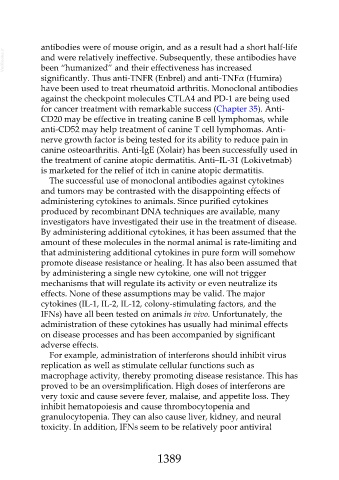Page 1389 - Veterinary Immunology, 10th Edition
P. 1389
antibodies were of mouse origin, and as a result had a short half-life
VetBooks.ir and were relatively ineffective. Subsequently, these antibodies have
been “humanized” and their effectiveness has increased
significantly. Thus anti-TNFR (Enbrel) and anti-TNFα (Humira)
have been used to treat rheumatoid arthritis. Monoclonal antibodies
against the checkpoint molecules CTLA4 and PD-1 are being used
for cancer treatment with remarkable success (Chapter 35). Anti-
CD20 may be effective in treating canine B cell lymphomas, while
anti-CD52 may help treatment of canine T cell lymphomas. Anti-
nerve growth factor is being tested for its ability to reduce pain in
canine osteoarthritis. Anti-IgE (Xolair) has been successfully used in
the treatment of canine atopic dermatitis. Anti–IL-31 (Lokivetmab)
is marketed for the relief of itch in canine atopic dermatitis.
The successful use of monoclonal antibodies against cytokines
and tumors may be contrasted with the disappointing effects of
administering cytokines to animals. Since purified cytokines
produced by recombinant DNA techniques are available, many
investigators have investigated their use in the treatment of disease.
By administering additional cytokines, it has been assumed that the
amount of these molecules in the normal animal is rate-limiting and
that administering additional cytokines in pure form will somehow
promote disease resistance or healing. It has also been assumed that
by administering a single new cytokine, one will not trigger
mechanisms that will regulate its activity or even neutralize its
effects. None of these assumptions may be valid. The major
cytokines (IL-1, IL-2, IL-12, colony-stimulating factors, and the
IFNs) have all been tested on animals in vivo. Unfortunately, the
administration of these cytokines has usually had minimal effects
on disease processes and has been accompanied by significant
adverse effects.
For example, administration of interferons should inhibit virus
replication as well as stimulate cellular functions such as
macrophage activity, thereby promoting disease resistance. This has
proved to be an oversimplification. High doses of interferons are
very toxic and cause severe fever, malaise, and appetite loss. They
inhibit hematopoiesis and cause thrombocytopenia and
granulocytopenia. They can also cause liver, kidney, and neural
toxicity. In addition, IFNs seem to be relatively poor antiviral
1389

